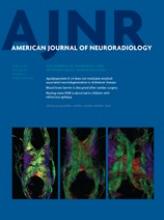Research ArticleBrain
Automated Determination of Brain Parenchymal Fraction in Multiple Sclerosis
M. Vågberg, T. Lindqvist, K. Ambarki, J.B.M. Warntjes, P. Sundström, R. Birgander and A. Svenningsson
American Journal of Neuroradiology March 2013, 34 (3) 498-504; DOI: https://doi.org/10.3174/ajnr.A3262
M. Vågberg
aFrom the Department of Pharmacology and Clinical Neuroscience, Section of Neuroscience (M.V., P.S., A.S.)
T. Lindqvist
bDepartment of Radiation Sciences, Diagnostic Radiology (T.L., K.A., R.B.)
K. Ambarki
bDepartment of Radiation Sciences, Diagnostic Radiology (T.L., K.A., R.B.)
cCenter for Biomedical Engineering and Physics (K.A.), Umeå University, Umeå, Sweden
J.B.M. Warntjes
dCenter for Medical Imaging Science and Visualization and Division of Clinical Physiology, Department of Medicine and Health (J.B.M.W.), Linköping University, Linköping, Sweden.
P. Sundström
aFrom the Department of Pharmacology and Clinical Neuroscience, Section of Neuroscience (M.V., P.S., A.S.)
R. Birgander
bDepartment of Radiation Sciences, Diagnostic Radiology (T.L., K.A., R.B.)
A. Svenningsson
aFrom the Department of Pharmacology and Clinical Neuroscience, Section of Neuroscience (M.V., P.S., A.S.)

References
- 1.↵
- Grassiot B,
- Desgranges B,
- Eustache F,
- et al
- 2.↵
- Rudick RA,
- Fisher E,
- Lee JC,
- et al
- 3.↵
- Kassubek J,
- Tumani H,
- Ecker D,
- et al
- 4.↵
- Sharma J,
- Sanfilipo MP,
- Benedict RH,
- et al
- 5.↵
- Bermel RA,
- Sharma J,
- Tjoa CW,
- et al
- 6.↵
- Chard DT,
- Griffin CM,
- Parker GJ,
- et al
- 7.↵
- Bermel RA,
- Bakshi R
- 8.↵
- Miller DH,
- Barkhof F,
- Frank JA,
- et al
- 9.↵
- Jovicich J,
- Czanner S,
- Han X,
- et al
- 10.↵
- Riederer SJ,
- Lee JN,
- Farzaneh F,
- et al
- 11.↵
- Bobman SA,
- Riederer SJ,
- Lee JN,
- et al
- 12.↵
- Redpath TW,
- Smith FW,
- Hutchison JM
- 13.↵
- 14.↵
- Alfano B,
- Brunetti A,
- Arpaia M,
- et al
- 15.↵
- Alfano B,
- Brunetti A,
- Covelli EM,
- et al
- 16.↵
- Alfano B,
- Brunetti A,
- Larobina M,
- et al
- 17.↵
- 18.↵
- Ambarki K,
- Lindqvist T,
- Wåhlin A,
- et al
- 19.↵
- 20.↵
- Ambarki K,
- Wahlin A,
- Birgander R,
- et al
- 21.↵
- Polman CH,
- Reingold SC,
- Banwell B,
- et al
- 22.↵
- Altman DG,
- Bland JM
- 23.↵
- Vrenken H,
- Geurts JJ,
- Knol DL,
- et al
- 24.↵
- Ge Y,
- Grossman RI,
- Udupa JK,
- et al
- 25.↵
- Zivadinov R,
- Grop A,
- Sharma J,
- et al
- 26.↵
- Horsfield MA,
- Rovaris M,
- Rocca MA,
- et al
- 27.↵
- Smith SM,
- Zhang Y,
- Jenkinson M,
- et al
- 28.↵
- 29.↵
- Battaglini M,
- Jenkinson M,
- De Stefano N
- 30.↵
In this issue
Advertisement
M. Vågberg, T. Lindqvist, K. Ambarki, J.B.M. Warntjes, P. Sundström, R. Birgander, A. Svenningsson
Automated Determination of Brain Parenchymal Fraction in Multiple Sclerosis
American Journal of Neuroradiology Mar 2013, 34 (3) 498-504; DOI: 10.3174/ajnr.A3262
0 Responses
Jump to section
Related Articles
- No related articles found.
Cited By...
- Synthetic MRI in Progressive MS: Associations with Disability
- Aging and the Brain: A Quantitative Study of Clinical CT Images
- Gadolinium Retention in the Brain: An MRI Relaxometry Study of Linear and Macrocyclic Gadolinium-Based Contrast Agents in Multiple Sclerosis
- Normal Values of Magnetic Relaxation Parameters of Spine Components with the Synthetic MRI Sequence
- Improved Precision of Automatic Brain Volume Measurements in Patients with Clinically Isolated Syndrome and Multiple Sclerosis Using Edema Correction
- Loss of corticospinal tract integrity in early MS disease stages
- Rituximab in multiple sclerosis: A retrospective observational study on safety and efficacy
- Clinical Feasibility of Synthetic MRI in Multiple Sclerosis: A Diagnostic and Volumetric Validation Study
- Quantitative MRI for Rapid and User-Independent Monitoring of Intracranial CSF Volume in Hydrocephalus
- Quantitative MRI for Analysis of Active Multiple Sclerosis Lesions without Gadolinium-Based Contrast Agent
- Effects of Gadolinium Contrast Agent Administration on Automatic Brain Tissue Classification of Patients with Multiple Sclerosis
This article has been cited by the following articles in journals that are participating in Crossref Cited-by Linking.
- Jonatan Salzer, Rasmus Svenningsson, Peter Alping, Lenka Novakova, Anna Björck, Katharina Fink, Protik Islam-Jakobsson, Clas Malmeström, Markus Axelsson, Mattias Vågberg, Peter Sundström, Jan Lycke, Fredrik Piehl, Anders SvenningssonNeurology 2016 87 20
- Akifumi Hagiwara, Marcel Warntjes, Masaaki Hori, Christina Andica, Misaki Nakazawa, Kanako Kunishima Kumamaru, Osamu Abe, Shigeki AokiInvestigative Radiology 2017 52 10
- T. Granberg, M. Uppman, F. Hashim, C. Cananau, L.E. Nordin, S. Shams, J. Berglund, Y. Forslin, P. Aspelin, S. Fredrikson, M. Kristoffersen-WibergAmerican Journal of Neuroradiology 2016 37 6
- Mattias Vågberg, Niklas Norgren, Ann Dring, Thomas Lindqvist, Richard Birgander, Henrik Zetterberg, Anders Svenningsson, Markus ReindlPLOS ONE 2015 10 8
- Ulrike W. Kaunzner, Susan A. GauthierTherapeutic Advances in Neurological Disorders 2017 10 6
- Irene Håkansson, Anders Tisell, Petra Cassel, Kaj Blennow, Henrik Zetterberg, Peter Lundberg, Charlotte Dahle, Magnus Vrethem, Jan ErnerudhJournal of Neuroinflammation 2018 15 1
- Anders Tisell, Olof Dahlqvist Leinhard, Jan Bertus Marcel Warntjes, Anne Aalto, Örjan Smedby, Anne-Marie Landtblom, Peter Lundberg, Richard Jay SmeynePLoS ONE 2013 8 4
- Janne West, Anne Aalto, Anders Tisell, Olof Dahlqvist Leinhard, Anne-Marie Landtblom, Örjan Smedby, Peter Lundberg, Pablo VillosladaPLoS ONE 2014 9 4
- I. Blystad, I. Håkansson, A. Tisell, J. Ernerudh, Ö. Smedby, P. Lundberg, E.-M. LarssonAmerican Journal of Neuroradiology 2016 37 1
- Sooyeon Ji, Dongjin Yang, Jongho Lee, Seung Hong Choi, Hyeonjin Kim, Koung Mi KangJournal of Magnetic Resonance Imaging 2022 55 4
More in this TOC Section
Similar Articles
Advertisement











